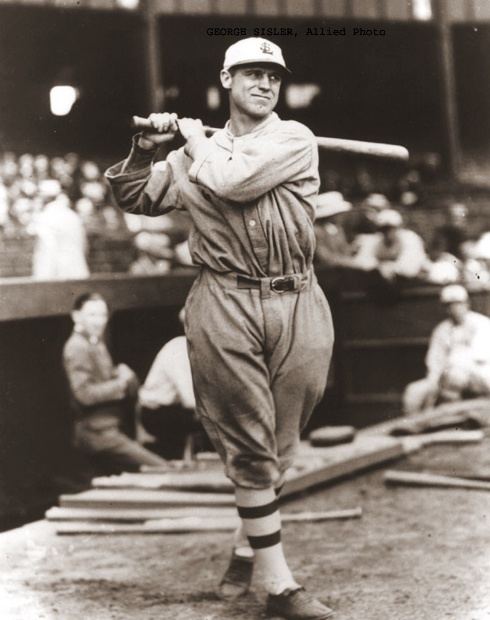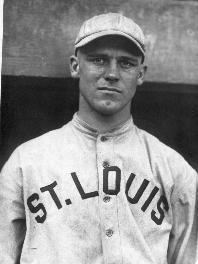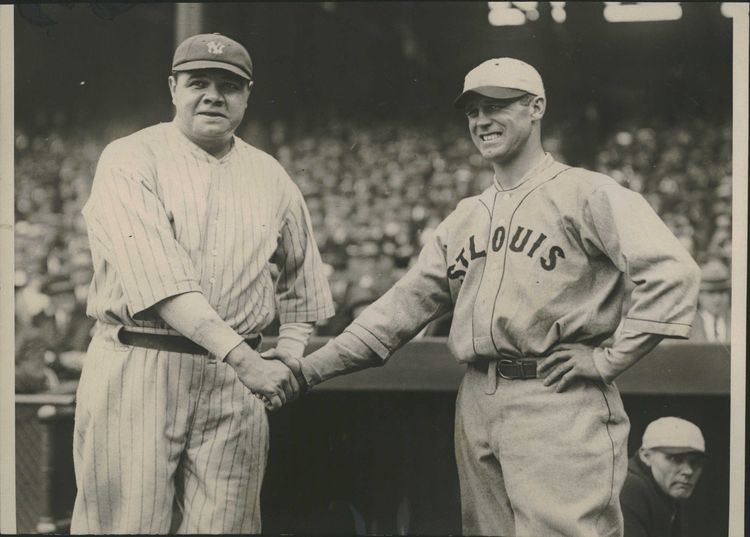Batting average .340 Vote 85.8% (fourth ballot) Runs batted in 1,175 Weight 77 kg | Home runs 102 Role Baseball player Hits 2,812 Name George Sisler Inducted 1939 | |
 | ||
Died March 26, 1973, Richmond Heights, Missouri, United States | ||
1939 hall of fame eddie collins george sisler and george sisler
George Harold Sisler (March 24, 1893 – March 26, 1973), nicknamed "Gentleman George" and "Gorgeous George", was an American professional baseball player for 15 seasons, primarily as first baseman with the St. Louis Browns. From 1920 until 2004, Sisler held the Major League Baseball (MLB) record for most hits in a single season with 257.
Contents
- 1939 hall of fame eddie collins george sisler and george sisler
- Inside Sports George Sisler
- Early life
- Major league career
- Later life and legacy
- References
Sisler's 1922 season — during which he batted .420, hit safely in a then-record 41 consecutive games, led the American League in hits (246), stolen bases (51), triples (18), and was probably the best fielding first baseman in the game — is considered by many historians to be among the best individual all-around single-season performances in baseball history.

After Sisler retired as a player he worked as a major league scout and aide. He was on a team of scouts appointed by Branch Rickey to find black players for the Brooklyn Dodgers; the team's work resulted in the signing of Jackie Robinson.

Sisler was elected to the Baseball Hall of Fame in 1939. In 1999 editors at The Sporting News named him 33rd on their list of "Baseball's 100 Greatest Players."

Inside Sports: George Sisler
Early life
Sisler was born in the unincorporated hamlet of Manchester (now part of the city of New Franklin, a suburb of Akron, Ohio). His paternal ancestors were immigrants from Northern Germany in the middle of the 19th century. When he was 14, Sisler moved to Akron to live with his older brother so that he could attend an accredited high school. When Sisler was a high school senior his brother died of tuberculosis, but Sisler was able to move in with a local family and finish school.
In 1911, Sisler signed a contract with the Pittsburgh Pirates to play minor league baseball in the Ohio–Pennsylvania League, but he never played in the league or earned any money and instead played college ball for the University of Michigan. As a freshman pitcher, Sisler struck out 20 batters in seven innings during a 1912 game. He lettered in baseball from 1913 to 1915. At Michigan he played for coach Branch Rickey while earning a degree in mechanical engineering.
After he graduated from Michigan, Sisler sought legal advice from Rickey about the status of his contract with Pittsburgh. The three-time Vanity Fair All-American had become highly sought-after by major league scouts. Rickey talked to Pittsburgh owner Barney Dreyfuss about releasing Sisler from the contract he had signed as a minor, but Dreyfuss maintained his claim to Sisler. Rickey wrote to the National Commission, baseball's governing body, who ruled that the contract was illegal. Rickey, now managing the St. Louis Browns, signed Sisler to a contract worth $7,400.
Major league career
Sisler entered the major leagues as a pitcher for the Browns in 1915. He posted a career pitching record of 5–6 with a 2.35 earned run average in 24 career mound appearances. He defeated Walter Johnson twice in complete-game victories. In 1916, Sisler moved to first base, and finished the season with a batting average above .300 for the first of seven consecutive seasons. He also had 34 stolen bases that season, and stole at least 28 bases in every season through 1922.
In 1917, Sisler hit .353, registered 190 hits and stole 37 bases. The next year he hit .341 and stole a league-leading 45 bases. He then enlisted in the army, joining several major league players in a Chemical Warfare Service unit commanded by Rickey. Sisler was preparing to go overseas when World War I ended that November.
In 1920, Sisler played every inning of each game. He stole 42 bases (second in the American League), collected a major league-leading 257 hits for an average of .407 and ended the season by hitting .442 in August and .448 in September. His batting average was the highest ever for a 600+ at-bat performance. In breaking Ty Cobb's 1911 record for hits in a single season, Sisler established a mark which stood until Ichiro Suzuki broke the record with 262 hits in 2004. (Suzuki, however, collected his hits over 161 games during the modern 162-game season as opposed to 154 in Sisler's era.) Sisler finished second in the AL in doubles and triples, as well as second to Babe Ruth in RBIs and home runs.
Jim Barrero of the Los Angeles Times asserts that Sisler's record was largely overshadowed by Ruth's 54 home runs that season. "Of course, Ruth's obliteration of the home run record drew all the attention from fans and newspapermen, while Sisler's mark was pushed to the side and perhaps left unappreciated during what was a golden age of pure hitters", Barrero wrote. As his popularity increased, Sisler drew comparisons to Cobb, Ruth and Tris Speaker. Sisler, however, was much more reserved than those three stars. Writer Floyd Bell described Sisler as "modest, almost to a point of bashfulness, as far from egotism as a blushing debutante... Shift the conversation to Sisler himself and he becomes a clam."
In 1922, Sisler hit safely in 41 consecutive games, an American League record that stood until Joe DiMaggio broke it in 1941. His .420 batting average is the third-highest of the 20th century, surpassed only by Rogers Hornsby's .424 in 1924 and Nap Lajoie's .426 in 1901. Sisler was chosen as the AL's Most Valuable Player that year, the first year an official league award was given, as the Browns finished second to the New York Yankees.
Sisler stole over 25 bases in every year from 1916 through 1922, peaking with 51 the last year and leading the league three times; he also scored an AL-best 134 runs, and hit 18 triples for the third year in a row.
A severe attack of sinusitis caused him double vision in 1923, forcing him to miss the entire season. He defied some predictions by returning in 1924 with a batting average over .300. Sisler later said, "I planned to get back in uniform for 1924. I just had to meet a ball with a good swing again, and then run. The doctors all said I'd never play again, but when you're fighting for something that actually keeps you alive – well, the human will is all you need." Sisler never regained his previous level of play, though he continued to hit over .300 in six of his last seven seasons and led the AL in stolen bases for a fourth time in 1927.
In 1928, the Browns sold Sisler's contract to the Washington Senators, who in turn sold the contract to the Boston Braves in May. After batting .340, .326, and .309 in his three years in Boston, he ended his major league career with the Braves in 1930, then played in the minor leagues. He accumulated a .340 lifetime batting average over his 16 years in the majors. Sisler stole 375 bases during his career. In 1939 he became one of the first entrants elected to the Baseball Hall of Fame.
Later life and legacy
After his playing career, Sisler reunited with Rickey as a special assignment scout and front-office aide with the St. Louis Cardinals, Brooklyn Dodgers and Pittsburgh Pirates. Sisler and Rickey worked with future Hall of Famer Duke Snider to teach the young Dodgers hitter to accurately judge the strike zone. Sisler was part of a scouting corps that Rickey assigned to look for black players, though the scouts thought they were looking for players to fill an all-black baseball team separate from MLB. Sisler evaluated Jackie Robinson as a potential star second baseman, but he was concerned about whether Robinson had enough arm strength to play shortstop. With the Pirates in 1961, Sisler had Roberto Clemente switch to a heavier bat. Clemente won the league batting title that season.
Sisler's sons Dick and Dave were also major league players in the 1950s. Sisler was a Dodgers scout in 1950 when his son Dick hit a game-winning home run against Brooklyn to clinch the pennant for the Phillies and eliminate the second-place Dodgers. When asked after the pennant winning game how he felt when his son beat his current team, the Dodgers, George replied, "I felt awful and terrific at the same time." A passage in The Old Man and the Sea refers to Dick Sisler's long home run drives. Another son, George Jr., served as a minor league executive and as the president of the International League.
Sisler also spent some time as commissioner of the National Baseball Congress. He died in Richmond Heights, Missouri, in 1973, while still employed as a scout for the Pirates.
Outside of St. Louis' Busch Stadium, there is a statue honoring Sisler. He is also honored with a star on the St. Louis Walk of Fame. In October 2004, Ichiro Suzuki broke Sisler's 84 years old hit record, collecting his 258th hit off of Texas Rangers pitcher Ryan Drese. Sisler's daughter Frances Sisler Drochelman and other of his family members were in attendance when the record was broken. While in St. Louis for the 2009 All-Star game, Ichiro Suzuki visited Sisler's grave site.
